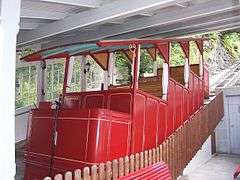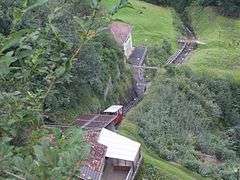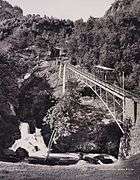Reichenbachfall Funicular
The Reichenbachfall Funicular (German: Reichenbachfall-Bahn; RfB) is a funicular in the Bernese Oberland region of the Swiss canton of Berne. It links Willigen, near Meiringen, with the uppermost of the Reichenbach Falls, famous as the site of the apparent death of Sir Arthur Conan Doyle's fictional hero, Sherlock Holmes. On its route the line follows and crosses the lower falls of the Reichenbach.[1][2]
| Reichenbachfall Funicular | |
|---|---|
 The lower station | |
| Overview | |
| Type | Funicular |
| Status | Open |
| Locale | Bernese Oberland, Canton of Berne, Switzerland |
| Termini | Willigen (Reichenbachfallbahn) Reichenbachfall |
| Stations | 2 |
| Operation | |
| Opened | 1899 |
| Technical | |
| Track length | 714 metres (2,343 ft) |
| Track gauge | Metre (3 ft 3 3⁄8 in) |
| Highest elevation | 843 metres (2,766 ft) |
| Maximum incline | 61% |
The funicular was opened in 1899, and was rebuilt in 1999 to the original design. Between 1912 and 1956, it was linked to Meiringen by the Meiringen–Reichenbach–Aareschlucht tramway. Today it is owned by the EWR Energie company, which operates the adjacent hydroelectric power plant, but is maintained by the neighbouring Kraftwerke Oberhasli company, which also operates several other lines in the area. It has the following parameters:[1][2][3][4]
| Number of cars | 2 |
| Number of stops | 3 |
| Configuration | Single track with passing loop |
| Track length | 714 metres (2,343 ft) |
| Rise | 242 metres (794 ft) |
| Maximum gradient | 61% |
| Track gauge | 1,000 mm (3 ft 3 3⁄8 in) metre gauge |
| Capacity | 24 passengers per car |
| Traction | Electric |
| Speed | 2 metres per second (6.6 ft/s) |
| Journey time | 7.5 mins |
The funicular operates only between May and mid-October. During this period it operates every 15 minutes from 09:00 to 17:00. The lower station is some 20 minutes walk, or a 6-minute bus ride, from Meiringen station on the Brünig railway line.[1][5]
Gallery
 Car in lower station
Car in lower station- At the passing loop
 Looking down on the upper station
Looking down on the upper station The line's longest bridge, circa 1910
The line's longest bridge, circa 1910
References
- Richard Green (2007). Railways in the Berner Oberland - Part 3. Today's Railways Europe: Issue 134: February 2007. Platform 5 Publishing Ltd.
- "61 036 Reichenbach Falls train, Meiringen, funicular". Swiss Inventory of Ropeways (in German). Swiss Confederation. Retrieved 2014-04-24.
- "Grimselwelt - Transport Lifts". KWO. Retrieved 2014-09-17.
- "Kraftwerke übernehmen Betrieb der Reichenbachfall-Bahn". bernerzeitung.ch. Berner Zeitung. 2013-01-16. Retrieved 2014-09-17.
- "Meiringen RfB–Reichenbachfall" (PDF). Bundesamt für Verkehr. Retrieved 2014-04-24.
External links

- Reichenbachfall Bahn page from Funimag
- Reichenbachfall-Bahn page on Grimselwelt web site